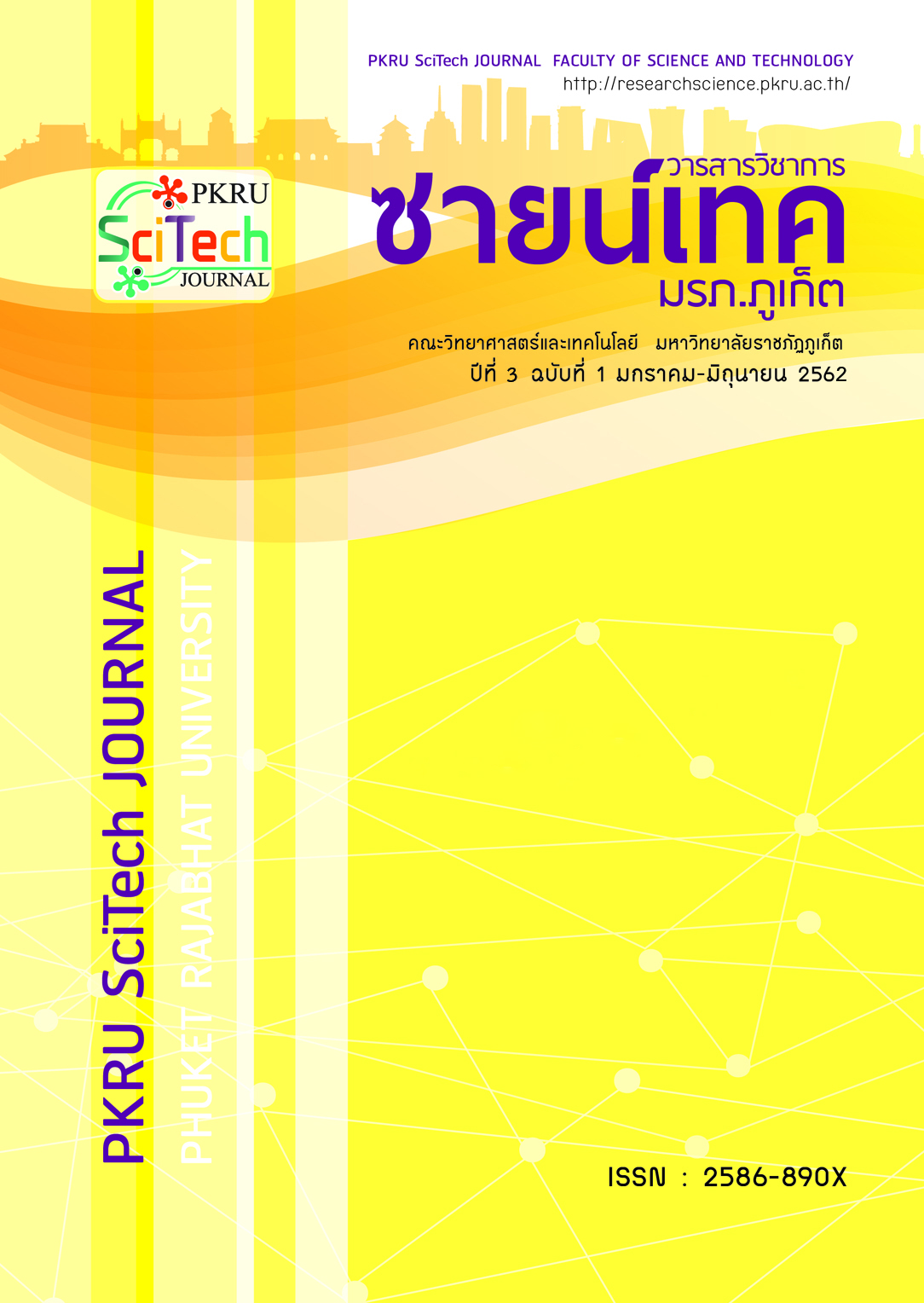กรดไขมันกับผลต่อสุขภาพ
Main Article Content
Abstract
กรดไขมันเป็นองค์ประกอบสำคัญของไขมันทั้งในพืช สัตว์ และจุลินทรีย์ ไม่พบเป็นอิสระในธรรมชาติส่วนมากเป็นเอสเทอร์ของกลีเซอรอลที่อยู่ในรูปของไตรกลีเซอไรด์ ถ้ามีพันธะเดี่ยวในโมเลกุล จัดเป็นกรดไขมันอิ่มตัว ถ้ามีพันธะคู่อยู่ในโมเลกุลจัดเป็นกรดไขมันไม่อิ่มตัว โครงสร้างทางเคมีของกรดไขมันเป็นสายโซ่คาร์บอนกับหมู่เมทิลที่ปลายด้านหนึ่งของโมเลกุล และหมู่คาร์บอกซิลที่ปลายอีกด้านหนึ่งกรดไขมันชนิดไม่อิ่มตัวที่มี 1 พันธะคู่ อาจพบตรงตำแหน่งที่แตกต่างกัน ที่พบส่วนมากมีความยาวของโซ่คาร์บอนอยู่ระหว่าง 12–22 และพันธะคู่เป็นแบบ cis กรดไขมันทรานส์เกิดขึ้นตามธรรมชาติในปริมาณที่น้อยพบในผลิตภัณฑ์ที่หลากหลาย เช่น เนยเทียม เนย มันฝรั่งทอด ช็อกโกแลตบาร์ ธัญพืช โดนัท คุกกี้ และขนมปัง อุตสาหกรรมอาหารใช้น้ำมันที่ผ่านการเติมไฮโดรเจนในการทอดอาหารหลายชนิด รวมทั้งมันฝรั่งทอด การเติมไฮโดรเจนจะไปเปลี่ยนกรดไขมันชนิดไม่อิ่มตัวในธรรมชาติ ให้เป็นกรดไขมันทรานส์ที่มีลักษณะเป็นของแข็งที่อุณหภูมิห้องและมีอายุการเก็บรักษาได้นานอย่างไรก็ตาม กรดไขมันทรานส์มีผลในความเป็นไปได้ที่จะเพิ่ม LDL VLDL และไตรกลีเซอไรด์ ลด HDL cholesterol เป็นสาเหตุของโรคหลอดเลือดแดงแข็ง
Article Details
- The original content that appears in this journal is the responsibility of the author excluding any typographical errors.
- The copyright of manuscripts that published in PKRU SciTech Journal is owned by PKRU SciTech Journal.
References
Sales-Campos, H., de Souza, P. R., Peghini, B. C., da Silva, J. S., & Cardoso, C.R. (2013). An overview of the modulatory effects of oleic acid in health and disease. Mini-Reviews in Medicinal Chemistry, 13, 1-10.
Bhardwaj, S., Passi, S. J., & Misra, A. (2011). Overview of trans fatty acids: Biochemistry and health effects. Diabetes and Metabolic Syndrome: Clinical Research and Reviews, 161-164.
Johnson, K., & Bradford, C. (2014). Omega-3, omega-6 and omega-9 fatty acids: implications for cardiovascular and other diseases. Journal of Glycomics Lipidomics, 4, 1-8.
Sorokin, A. V., Yang, Z., & Remaley, A. T. (2016). Anti-inflammatory and atheroprotective properties of omega-3 polyunsaturated fatty acids. Journal of Clinical and Experimental Cardiology, 7, 11.
Tortosa-Caparrós, E., Navas-Carrillo, D., Marín, F., & Orenes-Piñero, E. (2016). Anti-inflammatory effects of omega 3 and omega 6 polyunsaturated fatty acids in cardiovascular disease and metabolic syndrome. Critical Reviews in Food Science and Nutrition, 1-39.
Desnoyers, M., Gilbert, K., & Rousseau, G. (2018). Cardioprotective effects of omega-3 polyunsaturated fatty acids: dichotomy between experimental and clinical studies. Marine Drugs, 16, 234.
Harris W.S., Mozaffarian D., Rimm E., Kris-Etherton P., Rudel L.L., Appel L.J., Engler M.M., Engler M.B., & Sacks F. (2009). Omega-6 fatty acids and risk for cardiovasculardisease a science advisory from the american heart association nutrition subcommittee of the council on nutrition, physical activity, and metabolism; council on cardiovascular nursing; and council on epidemiology and prevention. Circulation, 19, 902-907.
Ricciotti, E., & FitzGerald, G. A. (2011). Prostaglandins and inflammation. Arteriosclerosis Thrombosis, and Vascular Biology, 31(5), 986–1000.
Liska, DeAnn J. Cook, C. M., Wang, D. D.,Gaine, P. C., & Baer, D. J. (2016). Trans fatty acids and cholesterol levels: An evidence map of the available science. Food and Chemical Toxicology, 98, 269-281.
Rustan, A. C., & Drevon, C. A. (2014). Fatty acids: structures and properties. Encyclopedia of Sciences & 2005, 1-7.
Miyauchi, S., Hirasawa, A., Iga T., Liu, N., Itsubo, C., Sadakane, K., Hara, T., & Tsujimoto, G. (2009). Distribution and regulation of protein expression of the free fatty acid receptor GPR120. Naunyn Schmiedebergs Archives of Pharmacology, 379, 427–434.
Cornall, L. M., Mathai, M. L., Hryciw, D. H., & McAinch, A. J. (2011). Diet-induced obesity up-regulates the abundance of GPR43 and GPR120 in a tissue specific manner. Cellular Physiology Biochemstry, 28, 949–958.
Farvid, M. S., Ding, M., Pan, A., Sun, Q., Chiuve, S. E., Steffen, L. M., Willett, W. C., Hu, F.B. (2014). Dietary linoleic acid and risk of coronary heart disease: A systematic review and meta-analysis of prospective cohort studies. Circulation, 130, 1568–1578.
Hunter, J. E. (2006). Dietary trans fatty acids: review of recent human studies and food industry responses. Lipids, 41(11), 967–992.
Takeuchi, H., & Sugano, M. (2017). Industrial trans fatty acid and serum cholesterol: the allowable dietary level. Journal of Lipids, 1-10.
Oomen, C. M., Ocke, M. C., Feskens, E. J. M., Van Erp- ´ Baart, M.-A. J., Kok, F. J., & Kromhout, D. (2001). Association between trans fatty acid intake and 10-year risk of coronary heart disease in the zutphen elderly study: a prospective population-based study. The Lancet, 357(9258), 746–751.
Bradley, B. H. R. (2018). Dietary fat and risk for type 2 diabetes: a review of recent research. Current Nutrition Reports, 7, 214–226.
Riserus, U. (2006). Trans fatty acids, insulin sensitivity and type 2 diabetes, Scandinavian. Journal of Food and Nutrition, 50(4), 161-165.
Thompson, A. K., Minihane, A-M., & Williams, C. M. (2011). Trans fatty acids, insulin resistance and diabetes. European Journal of Clinical Nutrition, 65, 553–564.


